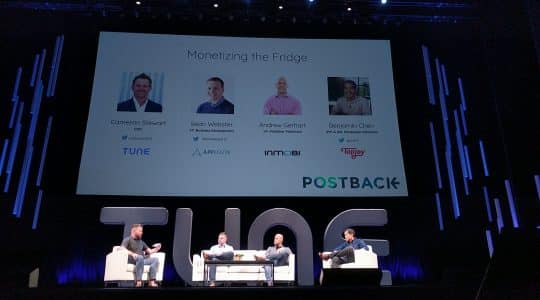It’s a well known metric that 80% of sales often comes from approximately 20% of your customers. Loyal customers are the driving force behind every successful business and companies have employed thousands of loyalty programs to bring back customers and turn them into repeat buyers.
With mobile, retailers have a new opportunity to turn consumers into loyal customers and gain new customers from competitors who don’t provide a quality mobile experience. MCommerce is growing at an extraordinary rate and by 2018 mCommerce is expected to equal the total amount of eCommerce that occurred in 2013. Increasing a mobile app’s retention and loyal customer base will instantly increase the amount of mCommerce flowing through a mobile app.
5 Ways to Increase Loyalty Among Mobile Shoppers
1. Incentivize With Mobile Offers, Coupons, and Rewards
Everyone likes a deal.
Creating exclusive offers, coupons, and rewards that cannot be claimed anywhere else but through the mobile app increases  engagement and drives repeat usage. Receiving a deal always feels good and customers will launch apps repeatedly to see what new deals are available.
engagement and drives repeat usage. Receiving a deal always feels good and customers will launch apps repeatedly to see what new deals are available.
Setting an expectation of new deals is important to continually engage customers. Make sure to update coupons every day, once a week, or once a month to set a rhythm that customers can look forward to. With the multitude of shopping options available it is important to stay top of mind, even when customers aren’t currently making a purchase.
To take your mobile coupons and offerings to the next level, you need to understand the different customer personas you have. Not all mobile customers are the same. Use the information you have about your customers to send the right coupons to the right segment of your customer base.
2. Utilize Geolocation & Store Mapping Technology
Location based features are a powerful tool for effective marketing campaigns, driving revenue, and adding value to your app for your mobile customers. Adding geolocation features into your mobile app allows you to send special offers or reminders to customers who are in store or close to one. Sending offers or information at relevant locations is a powerful mechanism for driving engagement and repeat usage.
For stores large and small, a map of the store layout can be extremely useful for the shopper with their mobile device in hand. For large stores, simply mapping out your store by product is extremely helpful. Going a step further, you can add information about products or even suggest a certain product to a customer based on their previous history and guide them to the product in store.
Displaying reminders and providing useful information at key buying intervals increases revenue opportunities, but even more so, they become features that mobile customers look for and will rely on in the future. While the purchase may end up being completed off of mobile, mobile is a key component to driving many sales made today in brick-and-mortar stores.
3. Optimize Your Marketing
Due to high rates of people not allowing push notifications, you can’t have your mobile marketing campaigns rely on push. For too long, marketing campaigns with links to products or offers would open up in a mobile browser, even if the customer had the app installed on the phone. One of the largest changes in mobile marketing is due to deeplinks.
 Using deeplinks in your email marketing, social media, and mobile ad campaigns allows your campaigns to direct customers directly to the right page in the app they already have installed on your phone.
Using deeplinks in your email marketing, social media, and mobile ad campaigns allows your campaigns to direct customers directly to the right page in the app they already have installed on your phone.
A simple but often forgotten method to increase your mobile shopper customer base is to constantly remind them that you have a mobile app! Through your email marketing campaigns, social media, and especially on your website, you have an opportunity to remind your customers that you have a mobile app that they can use. Always use your other outlets to remind and promote your mobile apps.
4. Refine the User Experience
No matter how well you guide, remind, or incentivize customers to use or revisit your mobile app, if it is unusable it won’t get used. It’s that simple.
For shopping apps, there are three main goals that need to be easily accomplishable – navigation, search, and check-out.
Whether it is a sidebar menu or tabs at the top of the screen, navigating through the app needs to be quick and simple. For shopping, customers often drill deep into categories to find the item they are looking for. It needs to be easy to navigate to any part of the app, repeatedly tapping the back button is not a solution.
Search is a relatively simple feature, but make sure you have it and it works.
The friction around check out has been a problem for eCommerce for years. People just don’t like forms. Due to the screen size and capabilities of mobile, filling out a form is even more painful. If customers already have an account, make sure it is easy to log into and has as much of their information automatically entered. Lastly, use the entire page and make the input fields and buttons large. Multiple pages of forms are better than one long page with small inputs that are difficult to use.
These functions are extremely important to a shopping app, but the most important thing to remember is performance. If your app is slow, crashes, or has bugs that consistently interrupt the customer experience you’ll find that your app is turning into a negative experience for your customers.
5. Prioritize the Customer
Put the customer first and create an app they love to use. To create an app that your customers love to use, you need to understand what they want, expect, and need from a shopping app. In short, this means you need to listen to your customers.
Using feedback forms and mobile surveys are important tools to understand what your customers want. Take that feedback and incorporate it into your product development cycles. By pushing out improvements to what is most important to your customer you’ll be creating a happy customer base.
Providing help and support during the shopping experience is crucial. Customers are quick to abandon transactions when their questions and concerns are not addressed quickly. When customers have a problem using a mobile app, they need to be able to receive support from inside the app. Even though customers may be upset when something goes wrong, they are quick to appreciate a company who actively tries to solve their problem. If handled correctly, customers with problems that get solved often become the loudest evangelists for a company.
Every problem and question you receive is an opportunity to make a customer happy. One of the best ways to turn your customers into loyal evangelists is by following up. Following up with your customers is the perfect way to close the feedback loop and gives your customers a sense of involvement with the app. Following up to make sure their questions were answered, or to inform them that the feature they suggested has been released is a sure fire way to make them feel appreciated.
Not convinced that including engagement and loyalty focused features in your app is important? Here are some statistics that make it clear how important repeat customers are to retailers.
- Acquiring new customers can cost five times more than retaining existing customers.
- The customer profitability rate tends to increase over the life of a retained customer. Reducing customer churn by 5% can increase profits 25% to 125%.
- The probability of selling to an existing customer is 60% to 70%, while the probability of selling to a new prospect is 5% to 20%.
Loyalty isn’t earned in a day, it is earned day-by-day. You need to consistently provide value and support to your mobile customers to increase their loyalty. Be intelligent about their needs, their experience, and how you can make them happy. Loyalty isn’t about logic, it’s about emotion. Companies that utilize apps to support their customers and work to provide relevant experiences will win over customers and increase the loyalty of their mobile customer base.
Author
Becky is the Senior Content Marketing Manager at TUNE. Before TUNE, she handled content strategy and marketing communications at several tech startups in the Bay Area. Becky received her bachelor's degree in English from Wake Forest University. After a decade in San Francisco and Seattle, she has returned home to Charleston, SC, where you can find her strolling through Hampton Park with her pup and enjoying the simple things in life.




Leave a Reply
You must be logged in to post a comment.